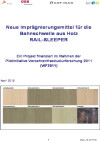RAIL-SLEEPER - New impregnating agents for wooden railway sleeper
Short Description
Starting point / motivation
At the beginning of the project, a probable ban of the use of creosote for impregnation of wooden railway sleepers, due to new Biocide Products Directive (98/8/EC) was assumed. The aim of this project was the examination of products with a better human- and eco-toxicological profile than creosote as alternatives for this application.
Contents and goals
It was necessary to find alternatives to creosote which provide the same key properties:
- high biological efficacy,
- long service-life,
- no increase of corrosion of metal fixings,
- low conductivity of impregnated sleepers and
- high resistance against physical and chemical stress.
Methods
Biological efficacy against all decay organism and required product concentration were determined in fungal experiments. Compatibility of the alternative products with metal fixings and effects of alternative products on conductivity were investigated incorporating moisture uptake of impregnated wood. Creosote is known to reduce moisture absorption of treated wood. This behaviour cannot be expected with the alternative products.
Possibilities to achieve this target with the modern, chromium free impregnation products were modifications of amounts of formulation adjuvants or application of water-repellents. In this project both approaches were attempted.
Resistance against ultraviolet light, heat and low temperatures as well as against oils and lubricants was studied with special regard to water repellent effects. Flammability and fire resistance of impregnated beech samples were comparatively investigated with untreated and creosote impregnated beech samples.
Results and Conclusions
The performed analysis showed that potential alternatives for the impregnation of rail-sleepers exist. However, a further analysis of these alternatives regarding impregnation quality, penetration, soaking and active substance distribution in the rail-sleepers is necessary.
Publications
RAIL-SLEEPER - New impregnating agents for wooden railway sleeper

In this project products with a better toxicological profile than creosote are under examination as alternatives for the impregnation of wooden railway sleepers. The demanded key properties have to be geared to those shown by creosote: high biological efficacy, long service-life, no increase of corrosion, low conductivity of impregnated sleepers and high resistance against physical and chemical stress.
Mag. Notburga Pfabigan
Publisher: BMVIT
German, 47 Seiten
Publication Downloads
Project Partners
Projct management
Mag.a Notburga Pfabigan - Holzforschung Austria - Austrian Forest Products Research Society, Forschungsinstitut und akkreditierte Prüf- und Überwachungsstelle der Österreichischen Gesellschaft für Holzforschung
Contact Address
Holzforschung Austria - Austrian Forest Products Research Society, Forschungsinstitut und akkreditierte Prüf- und Überwachungsstelle der Österreichischen Gesellschaft für Holzforschung
Mag.a Notburga Pfabigan
Tel.: +43 (1) 798 2623-23
E-mail: n.pfabigan@holzforschung.at
